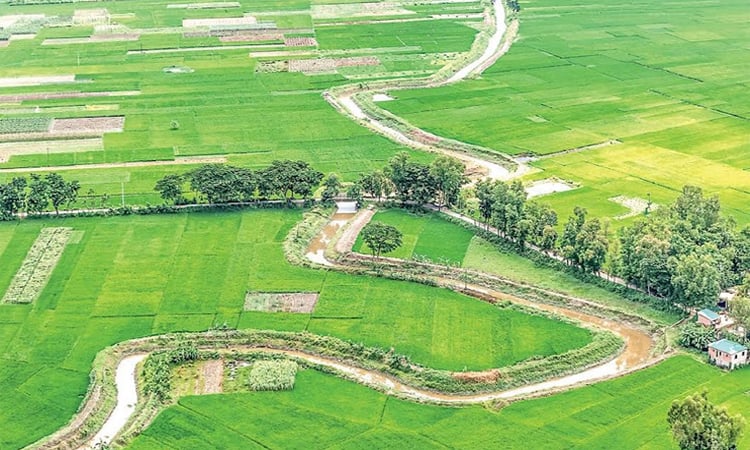News Flash

CHATTOGRAM, Nov 5, 2025 (BSS) - The Bangladesh Agricultural Development Corporation (BADC)'s re-excavation of canals under the ‘Irrigation Development Project (IDP) through the Use of Surface Water’ has brought renewed optimism to thousands of farmers in several upazilas of Chattogram, including Chandanaish and Satkania.
For generations, local farmers struggled to boost productivity amid recurring floods and long-lasting waterlogging. Rice seedlings were often submerged after planting, leaving lands unusable for months.
Now, with the re-excavation of long-neglected canals, farmers are planning for triple cropping and dreaming of tripling their income.
According to the Department of Agricultural Extension and local cultivators, agricultural productivity in Chattogram had long been constrained by its hilly topography, limited freshwater availability, irregular rainfall, and seasonal droughts. The situation, however, is changing rapidly.
Under the BADC's surface water irrigation project, canals once silted up or filled in are being restored - allowing water to flow freely again.
The initiative has increased annual crop yields significantly, especially in South Chattogram, where once single-crop lands now produce two or even three crops each year. This has lifted farmer morale and strengthened the drive toward national food self-sufficiency.
One of the project's key successes is the re-excavation of canals in the Charkhagaria Beel of Chandanaish upazila. The 18-kilometer Bharashankha-Satchhari canal, which runs through Chandanaish and Satkania, and the Nayakhal canal in Satkania's Kanchana Union have also been re-dug, rejuvenating both agriculture and local ecosystems.
Farmers said that until recently, knee-deep water lingered on their lands during monsoons, forcing them to abandon cultivation for much of the year. After re-excavation, excess rainwater now drains swiftly, while during high tide, fresh water from the Shankh River enters the canals - ensuring irrigation even in the dry months.
Using shallow pumps and ribbon pipes, farmers now transport water from the canal to their fields and return excess water back to the canal during low tide, effectively utilizing tidal water twice a day for irrigation.
Nurul Kabir, who cultivates three acres in Charkhagaria, said the canals were first dug during the tenure of Shaheed President Ziaur Rahman but later fell into neglect.
"After decades, the BADC has finally re-dug these canals, bringing immense benefits," he said. "We can now grow two crops where there used to be only one. Many of us are planning to cultivate three crops by adding Rabi crops with rice."
Farmer Nabirul Alam said they previously relied on deep tubewells during the dry season, but this year, tidal water has replaced groundwater for the first time.
"With tidal water, our rice yield has gone up from 80 maunds to 100 maunds per acre, and other crops are showing at least 20 percent higher output," he said.
Abdul Salam, another farmer, added that the re-excavated canal has made several thousand acres of land cultivable again. "This canal has changed our lives," he said.
The re-digging of the Nayakhal canal in Kanchana Union has not only eliminated persistent waterlogging but also provided irrigation water throughout the year. The newly cleared canal network in Chandanaish and Satkania has turned previously barren land productive and allowed both Aman and Boro rice cultivation.
Local school teacher Mozaffar Ahmed noted that the Bharashankha-Satchhari canal, which flows nearly 18 kilometers from hill streams through Bailtali, Khagaria, Satbaria, Dohazari, and Hasimpur unions before merging with the Shankh River, had been clogged for 25 years.
"The canal's upper stretch carries hill stream water, while the lower part is influenced by tidal flows," he said. "Its re-excavation has not only expanded agricultural land but also revived aquatic biodiversity, with small fish, frogs, and aquatic plants returning after years of disappearance."
Md. Belal Hossain, Assistant Engineer of BADC's Dohazari Zone, said that in the 2024-25 fiscal year, a two-kilometer section of the Charkhagaria canal was re-excavated under the surface water irrigation project, bringing about 600 acres of fallow land under cultivation.
"We also re-excavated 12 kilometers of the Bharashankha-Satchhari canal, which freed 4,000 acres from waterlogging and ensured irrigation coverage," he said. "Another six kilometers will be excavated this fiscal year."
Project Director Engineer Md. Nurul Islam said the initiative marks a major shift in agricultural development. "In the past, government projects focused mainly on the country's north and south," he said. "Now, we are witnessing an agricultural revolution in the eastern region, particularly in greater Chattogram."
He added that farming near hilly areas requires a different approach than in the plains.
"The region's tidal rivers offer a natural irrigation advantage," he explained. "By channeling these flows through canals, we can enhance productivity, reduce costs, and conserve groundwater - leading to sustainable, high-yield agriculture."
With restored canals, rejuvenated fields, and revitalized biodiversity, Chattogram's farmers are now witnessing a long-awaited agricultural renaissance - one canal at a time.